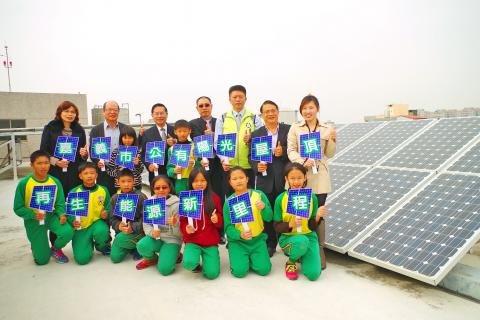Chiayi City Government is promoting a plan for 10,000 buildings to have solar panels installed on their roofs. By the end of this year, it will have finished installing solar power generation systems on a total of 38 halls and dormitories belonging to 27 government departments and schools, and it estimates that these systems will generate 3.55 million kilowatt hours (kWh) of electricity each year. On Dec. 17, Jhih Hang Elementary School announced the preliminary results achieved by implementing this project at the school. From September to November, the school’s solar panels generated about 52,000 kWh, for which it will be able to get an estimated rebate of NT$50,000.
Mayor Twu Shiing-jer says that Chiayi County, including Chiayi City, enjoys plenty of sunshine, making it suitable for developing solar power. Twu says the city is promoting environment-friendly energy resources, starting with government departments and schools, which can receive about 20.5 percent of the total revenue from selling the electricity they generate, and the solar projects can also be a teaching material for students.
Huang Kuo-tung, general manager of solar power company Anji Technology Co, says that Chiayi City gets an average of 5.7 hours of sunshine per day, which is quite good for generating electricity. The average rate for electricity sold to the Taiwan Power Co is NT$5 per kWh, out of which a rebate is paid to government departments and schools according to the ratio stipulated in the contract. It is tentatively estimated that the project will add NT$77 million to the city government’s revenues over 20 years.

Photo: Wang Shan-yen, Liberty Times
照片:自由時報記者王善嬿
Jhih Hang school principal Wu Chiu-feng says that the school has since 2006 been one of the model schools designated by the Ministry of Economic Affairs’ Bureau of Energy, and students from first to sixth grades all have lessons on the topic. In recent years, the school’s annual electricity bill has been around NT$350,000. Now it expects to make around NT$350,000 a year in rebates from selling electricity from its solar power equipment, so it hopes to cover the whole of its power bill.
(Liberty Times, translated by Julian Clegg)
嘉義市政府推動「陽光屋頂萬戶計畫」,年底前在二十七個機關、學校,共三十八棟廳、校舍的頂樓,建置完成太陽能光電發電系統,預計每年產電三百五十五萬度。十二月十七日在志航國小發表初步成果,九到十一月已發電約五‧二萬度,估計已可獲五萬元回饋金。
市長涂醒哲說,嘉市是陽光充足的縣市,適合發展太陽能發電,自公家機關、學校做起,推廣環保能源,可獲約百分之二十‧五的售電所得,並成為學生學習教材。
太陽能廠商安集科技總經理黃國棟表示,嘉市平均日照長度五‧七個小時,發電效能不錯,賣電給台電公司的價錢,平均每度五元,再依簽約比例回饋給機關、學校,初估二十年可替市府增加七千七百萬元收益。
志航國小校長吳秋鋒表示,該校自二零零六年起,就是經濟部能源局的示範學校,一到六年級都有相關課程,近年學校一年電費支出約三十五萬元,現有太陽能發電售電每年三十五萬元回饋金,可望充裕學校經費運用。
(自由時報記者王善嬿)

In an effort to fight phone scams, British mobile phone company O2 has introduced Daisy, an AI designed to engage phone con artists in time-wasting conversations. Daisy is portrayed as a kindly British granny, exploiting scammers’ tendency to target the elderly. Her voice, based on a real grandmother’s for authenticity, adds to her credibility in the role. “O2” has distributed several dedicated phone numbers online to direct scammers to Daisy instead of actual customers. When Daisy receives a call, she translates the scammers’ spoken words into text and then responds to them accordingly through a text-to-speech system. Remarkably, Daisy

Bilingual Story is a fictionalized account. 雙語故事部分內容純屬虛構。 Emma had reviewed 41 resumes that morning. While the ATS screened out 288 unqualified, she screened for AI slop. She could spot it a mile away. She muttered AI buzzwords like curses under her breath. “Team player.” “Results-driven.” “Stakeholder alignment.” “Leveraging core competencies.” Each resume reeked of AI modeling: a cemetery of cliches, tombstones of personality. AI wasn’t just changing hiring. It was draining the humanity from it. Then she found it: a plain PDF cover letter. No template. No design flourishes. The first line read: “I once tried to automate my

Every May 1, Hawaii comes alive with Lei Day, a festival celebrating the rich culture and spirit of the islands. Initiated in 1927 by the poet Don Blanding, Lei Day began as a tribute to the Hawaiian custom of making and wearing leis. The idea was quickly adopted and officially recognized as a holiday in 1929, and leis have since become a symbol of local pride and cultural preservation. In Hawaiian culture, leis are more than decorative garlands made from flowers, shells or feathers. For Hawaiians, giving a lei is as natural as saying “aloha.” It shows love and

1. 他走出門,左右看一下,就過了馬路。 ˇ He walked outside, looked left and right, and crossed the road. χ He walked outside and looked left and right, crossed the road. 註︰並列連接詞 and 在這句中連接三個述語。一般的結構是 x, y, and z。x and y and z 是加強語氣的結構,x and y, z 則不可以。 2. 他們知道自己的弱點以及如何趕上其他競爭者。 ˇ They saw where their weak points lay and how they could catch up with the other competitors. χ They saw where their weak points lay and how to catch up with the other competitors. 註:and 一般連接同等成分,結構相等的單詞、片語或子句。誤句中 and 的前面是子句,後面是不定詞片語,不能用 and 連接,必須把不定詞片語改為子句,and 前後的結構才相等。 3. 她坐上計程車,直接到機場。 ˇ She took a cab, which took her straight to the airport. ˇ She took a cab and it took her straight